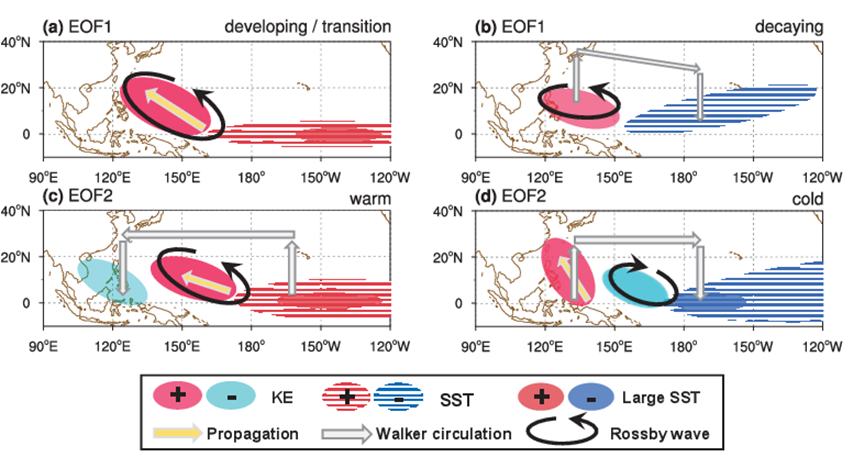Editor: 谢佳 Author: Time: 2023-10-19 Number of visits :117
The tropical western North Pacific displays prominent synoptic-scale disturbances (SSD) during boreal summer. Those SSDs play an important role in tropical weather and climate by inducing extremely heavy rainfall events, leading to the genesis of tropical cyclones (TC) over the tropical WNP, and contributing to the onset of the South China Sea summer monsoon. In this study, Gu et al. (2023) investigated interannual variations of boreal summer SSD intensity (measured using the kinetic energy of 3-9-day filtered 850 hPa winds) over the tropical western North Pacific and the associated factors. The first EOF mode of the SSD intensity variation displays a southeast-northwest tilted structure. The second EOF mode features a west-east contrasting pattern. The third EOF mode has a large loading over the subtropical western North Pacific.
Gu et al. (2023) revealed three different ways by which El Niño–Southern Oscillation (ENSO) influences the intensity of the SSDs over the tropical western North Pacific. The first way is a Rossby wave response to the equatorial central-eastern Pacific sea surface temperature (SST) anomalies (Fig. 1a), which modulates the seasonal mean background fields over the source region and along the propagation path of the SSDs. The second way is an anomalous Walker circulation response (Figs. 1c, 1d) that modulates the seasonal mean background fields over the far western equatorial Pacific that is a source region of northward propagating SSDs. The third way is an anomalous Walker circulation response that modulates the seasonal mean background fields over the Philippine Sea (Fig. 1b). The first and third ways operate for the first mode and the first and second ways work for the second mode.
Gu et al. (2023) documented the barotropic energy conversion associated with the three EOF modes. They found that the relative contributions of different terms of the barotropic energy conversion associated with the seasonal mean background fields vary with the region and differ among the three modes.
Gu, Q.-L., R. Wu*, and X. Cao, 2023: Interannual variations of synoptic-scale disturbance intensity over the tropical western North Pacific during boreal summer. Climate Dynamics, 61(3-4), 1913-1930. https://doi.org/10.1007/s00382-023-06663-4

Figure 1 Schematic diagram for the JJA SSD intensity variation of the EOF1 mode in (a) ENSO developing and transition years and (b) ENSO decaying years and the EOF2 mode in (c) warm and (d) cold years.
